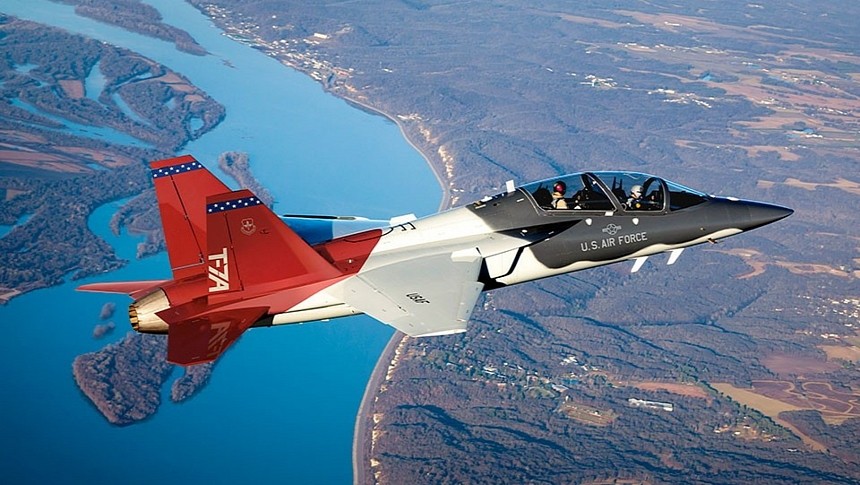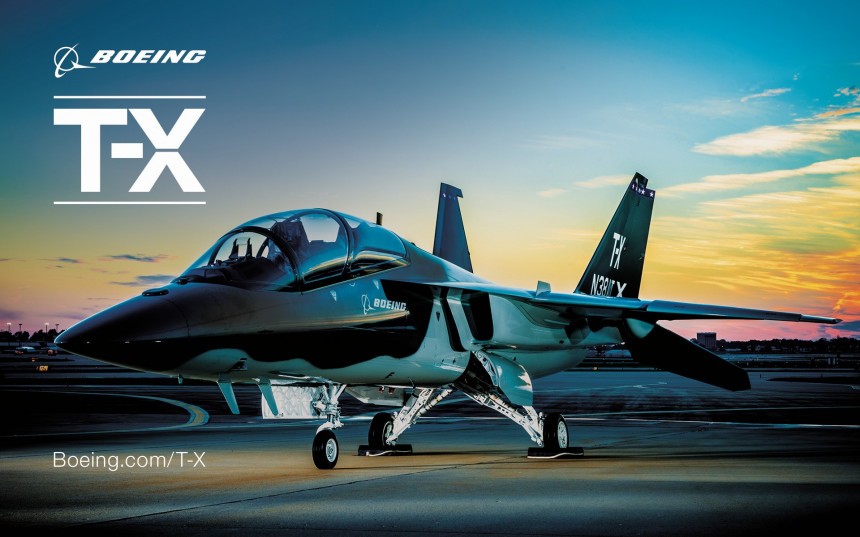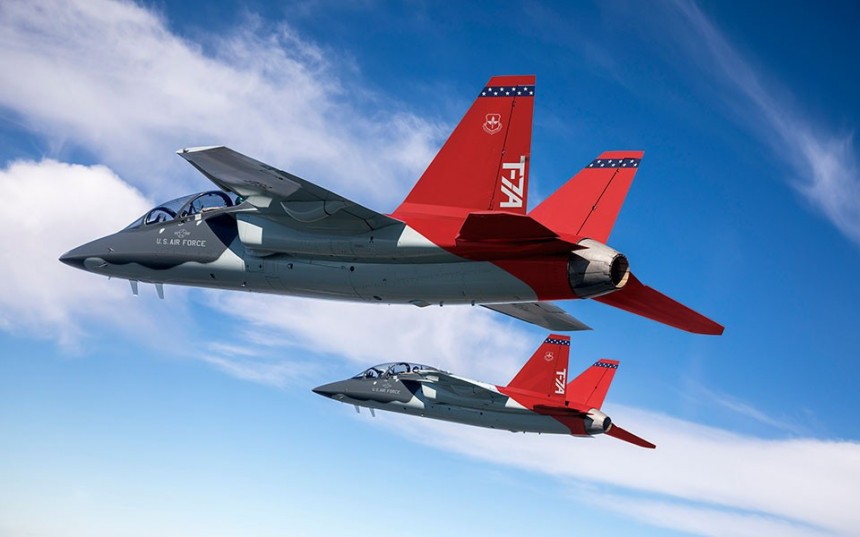When the United States Air Force wants something badly enough, they get it immediately and without hesitation, right? Well, the short answer to that is no. Even the Pentagon can get fleeced on a deal every now and then, or at least get kept waiting on something far longer than they ever anticipated. Don't believe us? Look no further than the Boeing-Saab T-7A Red Hawk, the twin-engine advanced jet trainer stuck in development hell.
But first, a brief history of American military trainer aircraft. Since the earliest days of American military aviation in World War I, the role of the aircraft trainer has been delegated to a mix of different aircraft ranging from outdated warbirds recently removed from combat to even civilian aircraft. Oftentimes, existing airframes are even redesigned by extending the fuselage and adding a second seat behind the pilot. During the First World War, the iconic Curtiss JN-4 Jenny Bi-Plane often took up this role. During World War II, the North American T-6 Texan became the trainer on which nearly all U.S. Army Air Force, Navy, and Marine Corps pilots came to grips with flight controls before taking a seat in Mustangs, Thunderbolts, Corsairs, and Hellcats.
Moving to the early Cold War, the Lockheed P-80 Shooting Star-based T-33 became the first turbojet-powered trainer in the American arsenal, along with its carrier-capable Navy variant, the TV2. But from the early 1960s to the present, one twin-engine jet trainer stood out above all else in the U.S. Military's arsenal. Of course, this would be the Northrop T-38 Talon. This twin-engine, supersonic advanced trainer prepared U.S. Air Force and Navy pilots to fly iconic jets of our time like the F-14, F-15, F-16, and F-18, as well as the Air Forces of Germany, Turkey, Portugal, South Korea, and Taiwan.
The T-38 has served as the gold standard for advanced jet trainers in active service for well over half a century. But not even the best warbirds can fly forever. By the late 2000s, decades of constant takeoffs, landings, and general aerial tomfoolery with novice pilots behind the stick had taken their toll on many T-38 airframes. A fatal accident involving a T-38 in 2008 was even blamed on metal fatigue in the Talon's airframe, compromising its structural integrity mid-flight. At this juncture, the U.S. Air Force's Air Education and Training Command (AETC) accelerated the development of an idea to replace the T-38 in the works since at least 2003. This project came to be known as the T-X program.
Of course, the landscape of the American military-aerospace complex was radically different in the 21st century than the last time the U.S. tried to design an advanced supersonic trainer. With a number of American aerospace firms collaborating with both European and Asian companies on the T-X competition, an American-centric operation this was not. But among a crowded contender field, the consortium of Boeing and the Swedish firm Saab, fresh off axing their automotive division, fielded an airframe that looked fantastic on paper.
Though sporting only a single engine to the T-38 Talon's two, the T-7A Red Hawk looks mighty impressive on first impressions. With an aggressively swept wing airframe mated to a prominent twin-tail rudder arrangement, there's no mistaking what a capable machine the Red Hawk was built to be. With dimensions of just under 47 feet long (14.3 m) with a wingspan a touch below 31 feet, the T-7A is only slightly smaller than the U.S.'s two premiere single-engine multi-role fighters, the F-16 Fighting Falcon and the F-35 Lightning II. Speaking of the F-35, the T-7A's advanced fly-by-wire control surfaces are intended to provide similar feedback to the control systems in the latest American stealth fighters.
Under the proverbial "hood" of the T-7A, it was decided the General Electric F404 turbojet engine would propel this novel trainer. With 17,200 lbs (77 kN) of thrust on offer at full afterburner, the same engine that powers the F/A-18 is well suited in an advanced trainer with a top speed hovering just above the Mach one, or roughly 800 mph (1,300 kph, 702 kn). The strength of Boeing and Saab's rock-solid reputation pre-737 MAX was an enormous help in netting the duo a $9.2 billion program contract to begin the path toward production in September 2018. Doing so less than two years after its first flight in December 2016.
By this stage, it appeared the T-7A was slated to outright replace all remaining T-38 Talon airframes sometime around 2023. With production contracts signed with the USAF to manufacture between 350 and 450 airframes, there'd certainly be enough inventory to finally retire the iconic T-38 by the mid-2020s. But all is not always well within the military-industrial complex. Even Boeing and Saab can overshoot deadlines and run into significant development problems. As quality analysis began on the first two T-7A airframes manufactured got underway, it was clear the Red Hawk was destined to be a problem child.
Questions regarding pilot safety plagued the first two prototype T-7As, particularly concerning its rocket-powered ejection seats, which experts fear could turn a real pilot into paste if ever used plagued the project in the late 2010s. As the project rolled into the 2020s, it was clear an introduction-to-service date of 2023 for the T-7A simply wasn't going to happen. Further investigations by the U.S. Government Accountability Office (GAO) appear to indicate the relationship between Boeing and the U.S. Air Force has become quite "tenuous" in light of the slipping development schedule.
As of June 2023, The T-7A's tentative introductory date has been pushed back to February 2025 and not a moment sooner. By this estimate, it's likely the type won't be ready for full-time training service until as late as 2027. That'd be four years past the date the AETC first anticipated the new jet would enter service when the project first got underway. Whether the schedule will continue to slip out of grasp or not remains to be seen. In the meantime, antique T-38s will likely have to stick it out just a little while longer.
Moving to the early Cold War, the Lockheed P-80 Shooting Star-based T-33 became the first turbojet-powered trainer in the American arsenal, along with its carrier-capable Navy variant, the TV2. But from the early 1960s to the present, one twin-engine jet trainer stood out above all else in the U.S. Military's arsenal. Of course, this would be the Northrop T-38 Talon. This twin-engine, supersonic advanced trainer prepared U.S. Air Force and Navy pilots to fly iconic jets of our time like the F-14, F-15, F-16, and F-18, as well as the Air Forces of Germany, Turkey, Portugal, South Korea, and Taiwan.
The T-38 has served as the gold standard for advanced jet trainers in active service for well over half a century. But not even the best warbirds can fly forever. By the late 2000s, decades of constant takeoffs, landings, and general aerial tomfoolery with novice pilots behind the stick had taken their toll on many T-38 airframes. A fatal accident involving a T-38 in 2008 was even blamed on metal fatigue in the Talon's airframe, compromising its structural integrity mid-flight. At this juncture, the U.S. Air Force's Air Education and Training Command (AETC) accelerated the development of an idea to replace the T-38 in the works since at least 2003. This project came to be known as the T-X program.
Of course, the landscape of the American military-aerospace complex was radically different in the 21st century than the last time the U.S. tried to design an advanced supersonic trainer. With a number of American aerospace firms collaborating with both European and Asian companies on the T-X competition, an American-centric operation this was not. But among a crowded contender field, the consortium of Boeing and the Swedish firm Saab, fresh off axing their automotive division, fielded an airframe that looked fantastic on paper.
Under the proverbial "hood" of the T-7A, it was decided the General Electric F404 turbojet engine would propel this novel trainer. With 17,200 lbs (77 kN) of thrust on offer at full afterburner, the same engine that powers the F/A-18 is well suited in an advanced trainer with a top speed hovering just above the Mach one, or roughly 800 mph (1,300 kph, 702 kn). The strength of Boeing and Saab's rock-solid reputation pre-737 MAX was an enormous help in netting the duo a $9.2 billion program contract to begin the path toward production in September 2018. Doing so less than two years after its first flight in December 2016.
By this stage, it appeared the T-7A was slated to outright replace all remaining T-38 Talon airframes sometime around 2023. With production contracts signed with the USAF to manufacture between 350 and 450 airframes, there'd certainly be enough inventory to finally retire the iconic T-38 by the mid-2020s. But all is not always well within the military-industrial complex. Even Boeing and Saab can overshoot deadlines and run into significant development problems. As quality analysis began on the first two T-7A airframes manufactured got underway, it was clear the Red Hawk was destined to be a problem child.
Questions regarding pilot safety plagued the first two prototype T-7As, particularly concerning its rocket-powered ejection seats, which experts fear could turn a real pilot into paste if ever used plagued the project in the late 2010s. As the project rolled into the 2020s, it was clear an introduction-to-service date of 2023 for the T-7A simply wasn't going to happen. Further investigations by the U.S. Government Accountability Office (GAO) appear to indicate the relationship between Boeing and the U.S. Air Force has become quite "tenuous" in light of the slipping development schedule.

















